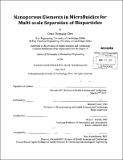| dc.contributor.advisor | Mehmet Toner. | en_US |
| dc.contributor.author | Chen, Grace Dongqing | en_US |
| dc.contributor.other | Harvard--MIT Program in Health Sciences and Technology. | en_US |
| dc.date.accessioned | 2012-09-13T19:37:20Z | |
| dc.date.available | 2012-09-13T19:37:20Z | |
| dc.date.copyright | 2012 | en_US |
| dc.date.issued | 2012 | en_US |
| dc.identifier.uri | http://hdl.handle.net/1721.1/72941 | |
| dc.description | Thesis (Ph. D. in Biomedical Engineering)--Harvard-MIT Program in Health Sciences and Technology, 2012. | en_US |
| dc.description | Cataloged from PDF version of thesis. | en_US |
| dc.description | Includes bibliographical references (p. 103-112). | en_US |
| dc.description.abstract | The efficient isolation of specific bioparticles in lab-on-a-chip platforms is important for many applications in clinical diagnostics and biomedical research. The majority of microfluidic devices designed for specific particle isolation are constructed of solid materials such as silicon, glass, or polymers. Such devices are hampered by some critical challenges: the low efficiency of particle-surface interactions in affinity based particle capture, the difficulty in accessing sub-micron particles, and design inflexibility between platforms for different particle sizes. Existing porous materials do not offer the structural properties or patterning capabilities to address these challenges. This work introduces Vertically Aligned Carbon Nanotubes (VACNTs) as a new porous material in microfluidics, and demonstrates the different ways in which it can improve bioparticle separation across both the micro and nano size scales. Our devices are fabricated by integrating patterned VACNT forests with ultra-high (99%) porosity inside of microfluidic channels. We demonstrated both mechanical and chemical capture of particles ranging over three orders of magnitude in size using simple device geometries. Nanoparticles below the inter-nanotube spacing (80 nm) of the forest can penetrate inside the forest and interact with the large surface area created by individual nanotubes. For larger particles (>80 nm), the ultra-high porosity of the nanotube elements enhances particlestructure interactions on the outer surface of the patterned nanoporous elements. We showed using both modeling and experiment that this enhancement is achieved through two mechanisms: the increase of direct interception and the reduction of near-surface hydrodynamic resistance. We verified that the improvement of interception efficiency also results in an increase in capture efficiency when comparing nanoporous VACNT post arrays with solid PDMS post arrays of the same geometry, using both bacteria and cells as model systems. The technology developed in this thesis can provide improved control of bioseparation processes to access a wide range of bioparticles, opening new pathways for both research and point-of-care diagnostics. | en_US |
| dc.description.statementofresponsibility | by Grace Dongqing Chen. | en_US |
| dc.format.extent | 112 p. | en_US |
| dc.language.iso | eng | en_US |
| dc.publisher | Massachusetts Institute of Technology | en_US |
| dc.rights | M.I.T. theses are protected by
copyright. They may be viewed from this source for any purpose, but
reproduction or distribution in any format is prohibited without written
permission. See provided URL for inquiries about permission. | en_US |
| dc.rights.uri | http://dspace.mit.edu/handle/1721.1/7582 | en_US |
| dc.subject | Harvard--MIT Program in Health Sciences and Technology. | en_US |
| dc.title | Nanoporous elements in microfluidics for multi-scale separation of bioparticles | en_US |
| dc.type | Thesis | en_US |
| dc.description.degree | Ph.D.in Biomedical Engineering | en_US |
| dc.contributor.department | Harvard University--MIT Division of Health Sciences and Technology | |
| dc.identifier.oclc | 809083196 | en_US |
